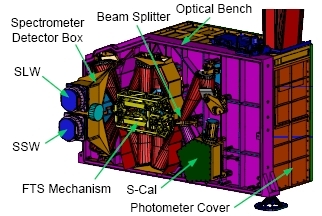The SPIRE photometer and spectrometer lie on the two sides of the optical bench panel.
The common input optics of the two instruments belong to the photometer and a pick-off mirror is used to direct the FTS field of view to the other side of the optical bench through a hole.
The main element of the common optics is a Beam Steering Mirror (BSM), which is placed at an intermedate pupil position and is used both for photometer and FTS observation.
The BSM can chop up to 4 arcmin amplitude along the long axis of the field of view and, simultaneously, it can chop in the orthogonal direction up to an amplitude of 30 arcsec.
This two-axis motion allows chopping and jiggling to remove background emissions and fully sample the image of the sky.
The optical bench panel, and all optical elements mounted directly from it, are at 4K.
In the photometer the beam is imaged simultaneously on the three bolometer arrays by using several reflecting mirrors and two dichroics.
The last mirror (M9) and dichroics are within a 2-K box.
The spectral passbands are defined by a sequence of metal mesh filters, and are centred at approximately 250, 350 and 500 µm
with λ/Δλ of 3.3, 3,4 and 2.5 respectively.
An internal calibration source provides a repeatable signal for the bolometers.
It is an emitting element at a temperature of about 80 K which radiates in the centre of the BSM.
It is not designed to provide an absolute calibration and it operates at regular interval in-flight in order to check the responsivity of the bolometers.
For further information, see the section in the Observer Manual.

SPIRE Spectrometer Optical layout.
Click on to see the full size image.
In the
Fourier-Transform Spectrometer, the incoming radiation is separated by a beam divider in a Mach-Zehnder configuration into two beams, which travel inside a Mirror Mechanism Box (MMB) before recombining.
Inside the MMB, a moving corner-cube mirror is used to change the Optical Path Difference of the two beams and the interference signal is directed onto the two spectrometer bolometer arrays.
The passbands for each array (194-324 µm and 316-672 µm) are defined by a sequence of mesh filters.
A thermal calibration source is located at the second input port of the FTS, which provides a radiation roughly equivalent to the dilute 80-K black body emission spectrum of the telescope.
The requirement of the calibration source is to be able to annull the central maximum of the interferogram.
For further information, see the
section in the Observer Manual.
Back to top

